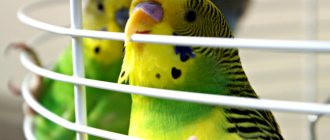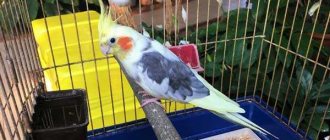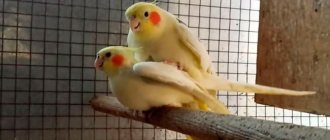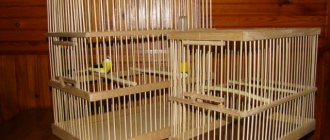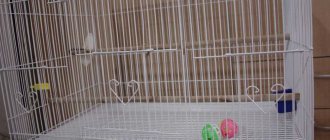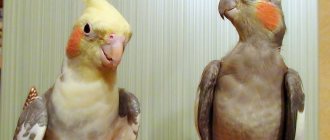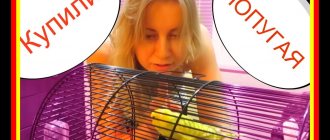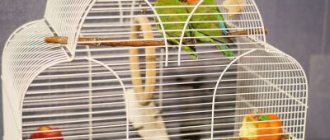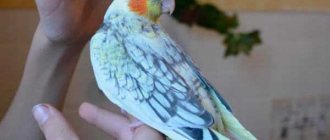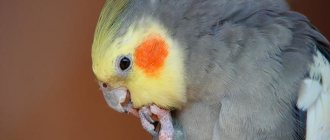Everything in our life happens for a reason. It is not for nothing that the radiant inhabitant of Australian woodlands was given a double sonorous name - nymph. Crested pets are famous for their good-natured disposition, sedateness, extraordinary affection for humans and longevity. If you draw an analogy with the beautiful ancient Greek deities, you will discover with interest that cockatiels are the animal embodiment of fairy-tale creatures. Not tolerant of fuss, playful and light parrots are not small birds, and therefore the home must be of appropriate size. And given the invisible connections with the Greek pantheon, it is truly royal.
Buying a cage for cockatiels is a must without any fuss. Having decided to acquire this type, you should carefully consider where it will stand, whether additional light sources are needed, whether the surrounding interior is safe, and much more.
Optimal design
The largest shelter possible will help to avoid injuries and prolong the joyful time of coexistence. A limited area can turn a cheerful pet, at best, into an apathetic, indifferent creature. The onset of depression and, as a consequence, health problems will completely lead the bird to death. Therefore, you need to understand the question of what kind of cage your cockatiel needs based on the recommendations of knowledgeable specialists.
Ornithologists advise choosing a home for your pet, carefully paying attention to the physiological characteristics of the chosen species. In this case we are dealing with a parrot the size of a pigeon. The wingspan covers a 30-centimeter space, so the width of the dwelling should be twice as large as these indicators. The height of the house takes into account the fact that birds like to hang with their tails up. As you know, it occupies more than half of the feathered body, and this plus another 60 cm. Staying on the perch should not crush the feathers; an ill-chosen height can break it. And, conversely, in this position the animal should not touch its head to the floor.
The main criterion for the size of a cockatiel's cell remains its length. In their natural habitat, animals cover distances of many kilometers and have proven themselves to be excellent flyers. When moving inside the cage space, the parrot should under no circumstances touch the walls or internal equipment. The resulting injuries, obesity and muscle atrophy accompanied by mental illness are the result of close living.
Form
Today, the structural diversity of feathered houses can satisfy even the most biased buyer: diamond-shaped, oval, square. However, when purchasing a home for a bird, you need to remember not about your desires, but about the comfort of the animal. Of course, cylindrical cages for a Corella parrot look impressive. But due to the lack of corners, the pet will not feel comfortable. After all, no one has yet canceled the presence of personal space. In addition, when moving around a round structure, the pet will not be able to linger anywhere, sliding down.
The most successful design is a rectangular structure. An abundance of angles, an oblong shape, a flat top of the roof, which will serve as an additional platform for games.
Dimensions
There are no thoroughly verified cell parameters. But there is a minimum cage size for a cockatiel, designed for one feathered resident:
- at least 80 cm length;
- 40 cm width;
- within 60 cm height.
Accordingly, for a feathered duo, the home should be twice as large. However, it is necessary to remember about daily walks around the room in order to give the freedom-loving bird the joy of free soaring.
Another equally important aspect of the housing dimensions is the width of the rods of the cockatiel’s cage. The distance between them varies from two to three centimeters. With large gaps, the head may get stuck when the parrot decides to explore the world outside the house. Small indentations look unethical, reminiscent of a prison rather than a home.
When choosing a feathered home, the weaving of the cage walls is of no small importance. If it is vertical, then the pet will constantly slide off, because climbing trees is inherent in nature. But on the other hand, it’s good for health; extra paw training won’t hurt. A good option with horizontal rods. But lattice walls are considered the optimally useful variety.
What is it made of?
Possessing a powerful beak and incredible curiosity, parrots are not averse to chewing on anything that is in bad shape. Therefore, when choosing cages for your cockatiel, you need to pay attention to the material from which it is made. It must meet all safety criteria.
- Durable design so that the animal does not end up in the wild one day.
- Environmental protection. You cannot purchase copper, galvanized or painted products. Small crumbs of zinc or paint, oxidized copper, can cause poisoning of a feathered pet. Wood is also not suitable for construction; it is very difficult to wash and clean wooden parts. Having swollen from water, it will lose its appearance, and the cracks that appear will serve as a breeding ground for dangerous pests. The most suitable material is stainless steel structures.
- Homogeneous surface without sharp corners, internal metal fasteners, or rough coating.
Creating a nesting house
You can make a nest for your cockatiel with your own hands, suitable for breeding birds. This nest is suitable for breeding birds. In order for parrots to lay eggs, you need to create ideal conditions for them.
Form
The nesting house can be of different shapes, both vertical and horizontal. It is important that it meets the following conditions:
- Several birds can easily fit into the house. It is enough for the parrot and the laying of eggs, as well as for the hatched babies.
- There is a small recess made in the bottom. It allows the eggs in the clutch not to move.
- There is a door on top or the roof is removable. This is needed for cleaning.
Dimensions
The nest should be roomy and spacious. The following dimensions are optimal for a vertical house: 25 length, 25 width, 30 height. For a horizontal house the following dimensions are needed: 30*30*40 cm.
Horizontal is considered the most convenient and comfortable for birds.
Materials
The material you can use is cardboard or wood. A paper house is built quickly, but it is short-lived. Ornithologists recommend using a cardboard nest only in case of emergency, in case of temporary housing for birds.
Wood is more durable, but weighs a lot. For such a nest you need a reliable and durable stand. Plywood may be the optimal solution.
Blueprints
Drawing of a small house for nesting birds. Equipped with an opening roof, an opening door and a small perch.
A more detailed drawing of the socket with indicated dimensions. The specified parameters are suitable for large cockatiels.
Step by step assembly
- Saw the plywood into 6 parts: 4 walls, roof and bottom.
- Cut a small hole in the wall with a diameter of 8 centimeters. Make a hole underneath for the perch.
- Fasten the walls and floor with self-tapping screws.
- Make a small nest out of polystyrene foam and place it on the bottom of the house.
- Attach the roof to the hinges.
- Install hooks to secure the house.
- Make a perch for the door.
- Fill the bottom with sawdust.
What should be in a cockatiel's cage?
For a long-term home stay, a pet needs everything for a full life. It is most rational to purchase an automatic waterer for cockatiels made of organic glass or plastic. Here the water will stay fresh longer. In open containers there is a possibility of contamination with grain husks, remnants of other food, as well as waste products. In the mandatory equipment of what should be in a cockatiel’s cage, it is advisable to include a variety of toys, all kinds of bars and perches, at least two.
How to set up a cockatiel's cage without a bathtub? This is contrary to feathered laws. Especially in the warm season, it is useful to relax and rinse your feathers.
Perches
Manufacturers often equip cages with plastic perches. You should avoid such perches - it will be inconvenient for the parrot to sharpen its claws and beak on them, and there is a high risk that it will eat harmful paint. The best material for a perch is natural wood. The product can be bought in a store or made independently.
Most tree species are suitable for raw materials, for example: apple, rowan, currant, birch and others. At the same time, experts do not recommend using oak, pear, bird cherry, poplar, and all types of coniferous trees due to the fact that they contain substances harmful to birds. Remember a few rules:
- if you make a perch yourself, avoid trees growing near roads and those that have been treated against insects;
- before placing the perches in the cage, they are washed, doused with boiling water and dried;
- the diameter of the perch should be 2 - 3 cm;
- Place perches at different heights.
DIY cockatiel cage
A good, solid home for a feathered friend is an expensive pleasure. And there is no guarantee that it will fully comply with all the above standards. That’s why more and more breeders prefer to set up cockatiel cages with their own hands. Nowadays it is not difficult to buy consumables; modern stores are teeming with an abundance of all kinds of tools. On the Internet, knowledgeable craftsmen post detailed reports on how a home-made cage becomes a parrot’s favorite habitat.
Where can I buy
Cages are sold at any pet store. For the most part, these are solutions for small birds - budgies and lovebirds. A wide range is offered by large retail outlets or specialized online stores.
It is better to give preference to branded options from reputable manufacturers. Such solutions are made of good material, certified, and safe for birds. In Russian, both European brands with premium models and more affordable Chinese options are presented.
Popular cell manufacturers:
- Sky (England);
- Ferplast (Italy);
- Savic (Belgium);
- IMAC (Italy);
- Triol (China);
- Inter-Zoo (Poland).
The cost of the cage depends on the size, material and equipment. Simple options for cockatiels from Triol can be found for 2-3 thousand rubles. Whereas prices for Italian Ferplast or IMAC start at 10 thousand rubles.
Aviary
Researchers note that this species is best kept in comfortable enclosures. But not everyone has this opportunity. Some breeders, from the point of view of productive education and training, place large areas on the wall. Pets located at eye level feel calmer and adapt to new knowledge faster. Enclosures for cockatiel parrots can be equipped with small wheels in order to move them to the most convenient places. Aesthetically, it looks luxurious.
Ideal location
- The cage should be placed in a well-lit place, away from heating devices, in the complete absence of drafts and noise. Such gentle creatures as cockatiels, although they come from Australia, are afraid of direct rays of the sun, so they can only be placed on a window if it is possible to create shade for them.
- It is better not to house birds in the kitchen or hallway. The kitchen is a place of high humidity. Now popular Teflon-coated cookware emits fumes that are toxic to parrots when heated. In the corridor there are often drafts and sudden changes in temperature.
- A TV, refrigerator, personal computers, Wi-Fi routers and other electrical appliances that emit radio and electromagnetic waves are not the best neighbors for your pet, so move him away from them.
- You should not install an apartment with a bird in your bedroom, otherwise you will be guaranteed to wake up at dawn from the cheerful singing of a cockatiel. Unless you cover your pet’s cage with a thick cloth at night - under it the bird will silently wait for the morning to come. In her case, it occurs when you lift the fabric.
- Place the cage with one side facing the wall - this will create a feeling of security for the parrot. But living in the center of the room, the cockatiel will feel unprotected and vulnerable.
- If you have other pets that could jump on the cage and knock it over, secure the house on all sides.
- Remove from the room with the parrot all plants that are poisonous to birds, as well as objects that you would not want the bird to chew and spoil.
Important! Place your cockatiel in a room where people often visit. These parrots are very social. If they spend a lot of time alone, they will quickly become bored, become depressed, begin to pull out their feathers, and become ill.
Position your parrot's house so that when it sits on its perch, it is at eye level with you. If the bird sits higher than you, it will develop incorrect relationships with people and perceive its position in the family as dominant. If the bird sits too low, it will overwhelm it.
Cleaning the cage and aviary
Maintaining hygiene and basic sanitary standards is the key to the longevity of a feathered pet. Therefore, when purchasing an aviary for a cockatiel parrot, it is worth asking whether a retractable tray is provided, so that you can clean it in a timely manner without disturbing the parrot. It is recommended to carry out sanitary days at least twice a week. Before using the cockatiel cage, it is recommended to treat all elements with boiling water. If you liked the article or have something to add, then leave your comments and also join our VKontakte group.
An important condition for keeping birds
Corella parrots are funny birds that can keep their owner and his family company. But living freely in an apartment is not the best option for a parrot. These pets need a cage. They will be safe in it while the owners are not around. Otherwise, the cockatiel may accidentally get injured, drown in a container with liquid, get stuck somewhere, catch a cold, or end up in the mouth of a dog or cat.
But we do not recommend buying the first cage you come across for your pet. For such freedom-loving birds as cockatiels, you need to choose a cage that will be suitable in both size and shape. In addition, it must be properly equipped so that the pet has something to do without getting injured.
So what should you pay attention to when choosing a cage for your cockatiel? Now we'll tell you.
Description
To keep a parrot in captivity, you will need certain devices that satisfy its basic needs. One of them is a bird cage, which ensures the safety of a pet in a person’s home.
On the market you can find a large number of cages of various shapes, sizes, and materials. Their prices also vary widely. There are inexpensive small models for keeping budgies or huge all-metal structures, more like indoor aviaries for large species of birds.
You can design a cage for your pet yourself, which allows you to take into account the individual characteristics of this individual. The main criteria for evaluating a product are design, size, material.
Description of homemade cages for parrots
There are the following types of housing:
- With all metal connection.
The cage is assembled from a mesh or lattice, fastened by spot welding or special devices.
- Combined option.
A plastic or wooden frame holds a metal lattice or mesh.
- All wooden or plastic cages.
They are less common, as they are not very durable and are quickly destroyed by the strong beak of the bird. The mesh and tray are made of the same materials.
